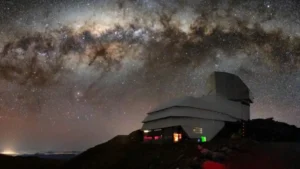Astronomers have spotted two giant plasma jets streaming from a supermassive black hole in a distant galaxy. At a mind-bending 23 million light-years long, they are the longest plasma jets on record.
140 galaxies long
The statistics are hard to fathom. The jets are blasting out of a black hole that sits 7.4 billion light years away. Each jet covers a distance equivalent to 140 Milky Way galaxies, and they are forcing researchers to rethink what they know about black holes.
Each light year is the equivalent of 5.8 trillion years, meaning these jets are far older than scientists expected. Researchers have named the jets Porphyrion after a giant in Greek mythology. They date to when the universe was 6.3 billion years old, less than half its current age.
Porphyrion’s jets are huge streams of charged ions and particles with a power that is equivalent to trillions of suns. The magnetic fields around the black holes are responsible for their incredible speed. Porphyrion is so large and old that astronomers think it, and other jets like it, likely played a role in the formation of the universe.
“Astronomers believe that galaxies and their central black holes co-evolve, and one key aspect of this is that jets can spread huge amounts of energy that affect the growth of their host galaxies and other galaxies near them. This discovery shows that their effects can extend much farther than we thought,” study co-author George Djorgovski commented.

The streaks in this LOFAR image show the immense length of the jets. Photo: LOFAR Collaboration/M. Oei/Caltech
One of 10,000 jet systems discovered
Researchers discovered the jet system during a survey using Europe’s Low Frequency Array Radio Telescope (LOFAR). They were amazed to find that it uncovered over 10,000 jet systems. Porphyrion was the largest in the group. Researchers knew that such giant structures existed, but never in this quantity.
“Usually when we get a new observational capability, such as LOFAR’s combination of wide field of view and very high sensitivity to extended structures, we find something new. But it was still very exciting to see so many of these objects emerging,” says co-author Martin Hardcastle.
Originally, the team was not looking for black hole jets. They were using LOFAR to look at the wispy filaments that crisscross the huge expanses between galaxies. Whilst analyzing the images, Aivin Gast noticed the first pair of jets.
It was quite the catch, Gast wasn’t even studying astronomy at the time. His degree was in archaeology and ancient history. He had offered to help friends look through the radio images. It was Gast who suggested the ancient Greek-inspired name.
Once the team saw a few of the jets, they began to actively look for them. They eventually found thousands.
Supermassive black holes sit in the middle of large galaxies. When the black holes are active, their gravitational force heats the surrounding area. The released energy takes the form of jets.
“We are learning that giant jets might be an age-old phenomenon. We now know they have existed for most of the universe’s life. Our LOFAR survey only covered 15% of the sky. Most of these giant jets are likely difficult to spot, so we believe there are many more of these behemoths out there,” lead author Martin Oei told CNN.






